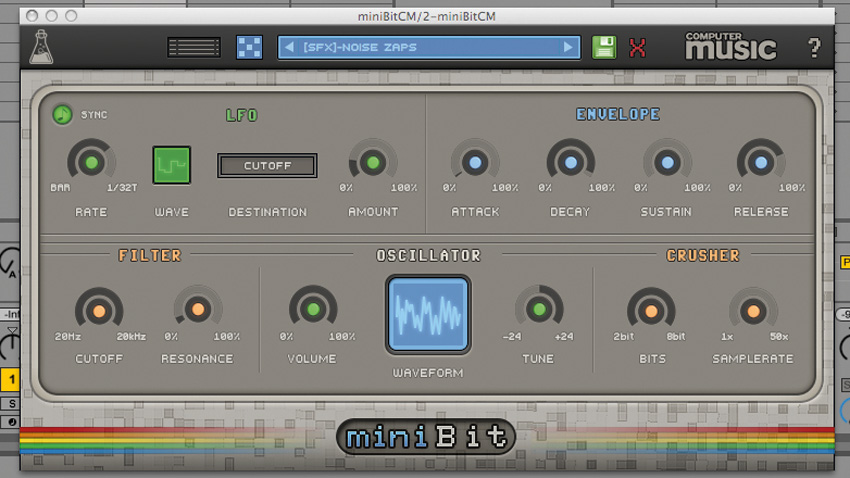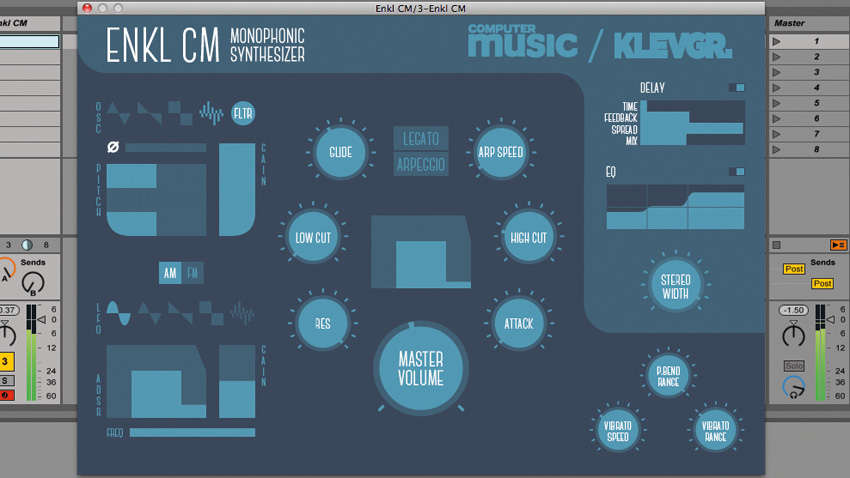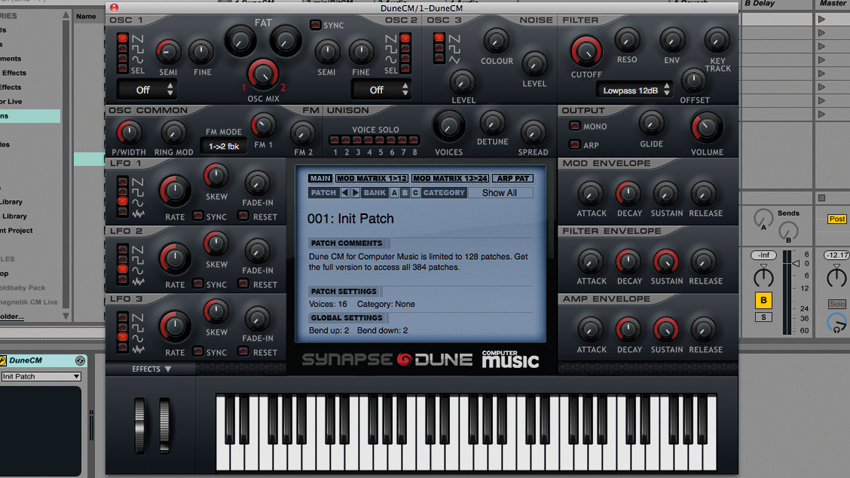10 classic synth FX... and how to create them
From risers and sweeps to soundscapes and all-out weirdness, build pro sound effects with your synths with our ten top techniques

SYNTH WEEK: When it comes to working sound effects into your electronic music productions, it can be all too easy to succumb to the obvious temptations of the prefab sample library.
But wouldn't you rather your FX - like, hopefully, everything else in your tracks - were uniquely your own? Of course you would, and the good news is that whether you're looking to create an energy-building riser, a bleepy sci-fi texture or an edgy retro videogame-style noise, your plugins folder is full of powerful synths that more than up to the job.
In this feature, we'll reveal ten tried and tested techniques for creating ear-catching synth FX quickly and easily, using a variety of commercial and free virtual instruments, the latter included with every issue of Computer Music magazine.
1. Next-level noise sweeps
Free with every issue of Computer Music from issue 227 onwards, Enkl CM is perfect for FX design thanks to its quirky AM/FM oscillator modulation, dual resonant filters and useful effects modules. For instance, try creating a modern twist on the ubiquitous 'white noise rise' effect by applying fast sine-shaped amplitude modulation (AM) to a white noise oscillator; next, crank the filter's resonance up to maximum, then sweep or automate the High Cut (ie, low-pass) filter from minimum to maximum for a howling, screaming riser. You can then use Enkl CM's onboard EQ and delay effects to add a brightening treble boost and wide delay taps.
2. Bubbling sample-and-hold effect
In the realm of synthesis, a 'sample and hold' waveform captures snapshots of a random noise source at regular intervals, generating a distinctive, bubbling 'random staircase' waveform that can be used to modulate other synth parameters. Its random nature makes it well suited to weird FX synthesis and sci-fi 'scapes - simply hook up a sample-and-hold LFO to modulate an oscillator's pitch before enjoying the distinctive gurgling effect heard throughout sci-fi cinema.
3. Put a ring on it
Ring modulation is the process of multiplying together two waveforms, with the output featuring the sum and difference frequency value(s) of the two waveforms. This creates additional harmonics called sidebands, generating bell-like and inharmonic tones that are ideal for clangorous FX creation. Many synths - such as XILS-lab XILS 3 CM, FabFilter Twin 2 and Computer Music's Dune CM - feature inbuilt ring modulator modules that enable you to combine two waveforms in this way.
4. Modular FX madness
There's a reason why synth heads become addicted to the Lego-style approach of modular synthesis: patching synth parameters, modulations and routings can generate unique sounds that regular pre-patched synthesisers often can't. Reaktor, Bazille and Moog Modular V are popular commercial plugin modulars worth checking out - and there's more modular madness in the CM Plugins folder, from Aalto CM and XILS 3 CM.
Get the MusicRadar Newsletter
Want all the hottest music and gear news, reviews, deals, features and more, direct to your inbox? Sign up here.

5. 8-bit blasts
The crunchy noise blasts and sweeps heard on countless videogame soundtracks of yesteryear are a doddle to synthesise with AudioThing's miniBit CM. Start with the synth's sample-based noise waveform, modulate the filter with a sample-and-hold LFO, then use the inbuilt sequencer at its fastest 1/32T speed to modulate the waveform's pitch and volume, creating stuttering lo-fi blasts.
6. One-knob wonders
Modern synth plugins such as NI's famous Massive have popularised the use of macros: by assigning multiple parameter movements to a single rotary control, it's possible to induce complex timbral shifts over time via automation. This technique is particularly useful when you're synthesising textural risers or evolving FX, as only the single macro needs to be automated throughout an arrangement. Start by creating a bread-and-butter riser effect by assigning an oscillator's pitch to a macro control, and automating the latter. Then move on to assigning other parameters to this same macro, focusing upon adding the maximum amount of change and interest throughout the course of the macro's movement.
7. Filters are doing it for themselves
The filters on many synths are self-oscillating: cranking the resonance up to max will cause such a filter to produce a tone of its own, which can be tuned to a specific frequency via the cutoff knob. While filter keytracking allows the makeshift oscillator to be played at corresponding pitches via MIDI, sweeping or modulating a self-resonating filter's cutoff is a technique best suited to the creation of sci-fi wobbles, zaps and pitch-sweeping FX. Try using an envelope to sharply sweep the filter's frequency down, creating a kick-like zap that you can bathe in reverb for a cavernous boom effect.

8. Wide inside
While you may like to widen your synth sounds with external plugins, be sure to first explore any inbuilt width-generating features. Oscillator auto-panning, oscillator spread, pseudo-widening and even delay modules can turn a static, centred synth tone into a stereo effect that fills out the stereo image. For example, try creating a simple patch in Enkl CM before using its Stereo Width knob and Delay effect to add impressive width. The big advantage of building stereo width into your patches like this is that you can recall the patch for later use, complete with a mix-filling stereo image.

9. FX design with FM
Famously popularised by the Yamaha DX7 hardware synthesiser, frequency modulation synthesis involves using the frequency of one oscillator to modulate the frequency of another, creating harmonically complex sounds. While careful application is often used to synthesise bells and realistic instruments, the effect can quickly descend into dissonance and weirdness - often highly desirable when designing FX! Have a go at cross-modulating the two oscillators against each other - ie, each performing FM on the other - for even weirder, more complex timbres.
10. Instant sci-fi risers
Synths with novel or unique LFO features can inspire numerous pitch-modulating effects - the Fade In parameter on Dune CM, for example, makes it easy to dial in evolving pitch modulation. Initialise Dune CM, change Oscillator 1 to a square wave, then turn the Fat knob up to 50% for detuned thickness. Next, use Dune CM's modulation matrix to assign an LFO to modulate the oscillator's pitch: set LFO 1 as the Source, Osc 1 Semi as the Destination, and set the maximum +100 amount of modulation for this routing. Next, switch LFO 1's shape to a square wave and apply a fast rate of 38Hz to give the square wave a gnarly, gritty timbre. In order for the modulation to open out over time, turn the LFO's Fade In amount up to between 8s and 10s, introducing the LFO's effect slowly after the sound starts, creating an interesting 'cross-pitching' effect as the modulation interacts with the square tone. Finally, add reverb or widening effects to make the sound even more enticing.
Synth Week is brought to you in association with Novation. For more tutorials, tips and features, check out the Synth Week hub page.
Computer Music magazine is the world’s best selling publication dedicated solely to making great music with your Mac or PC computer. Each issue it brings its lucky readers the best in cutting-edge tutorials, need-to-know, expert software reviews and even all the tools you actually need to make great music today, courtesy of our legendary CM Plugin Suite.










